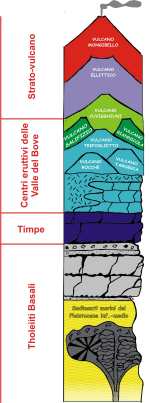The volcanic structure of Etna as we see it today, with almost
3400 metres of elevation
, is the result of the construction, one on top of the other, of many volcanic structures, whose position has changed over time.
 Therefore, Etna was “born” around 500,000 years ago.
Therefore, Etna was “born” around 500,000 years ago.
The oldest volcanic products are located in the area between Aci Castello and Aci Trezza, just north of Catania. These eruptive centres, dating back to previous ages, developed within a gulf, which over the millennia has been filled by both lava products and alluvial deposits from the Simeto river, the current Plain of Catania. The most ancient lava flows surface in the Adrano area and date back 330,000 years.
Between 250 and 130,000 years ago, the activity moved further north, forming a linear chain of volcanoes in the area of the present-day Timpe of Acireale.
Between 130 and 67,000 years ago, the activity moved inland, to the area of present-day Valle del Bove: here several eruptive centres were formed and destroyed over time, the biggest of which is the Trifoglietto.
Between 67 and 15,000 years ago, the activity moved even further inwards, coinciding with the present-day volcanic structure: this is the period of the Elliptical, a great
stratovolcano
that probably reached 3700 metres of elevation.
Finally, the current eruptive era began 15,000 years ago, the era of Mongibello, where the Valle del Bove was also formed.